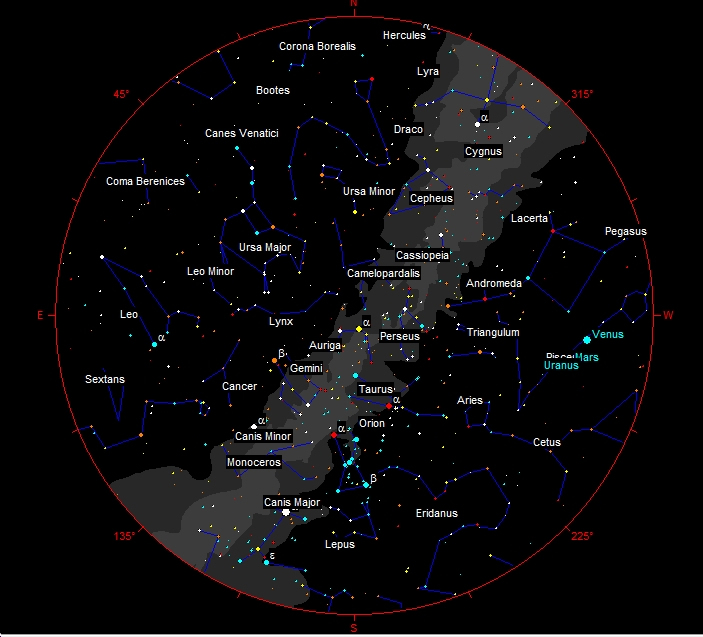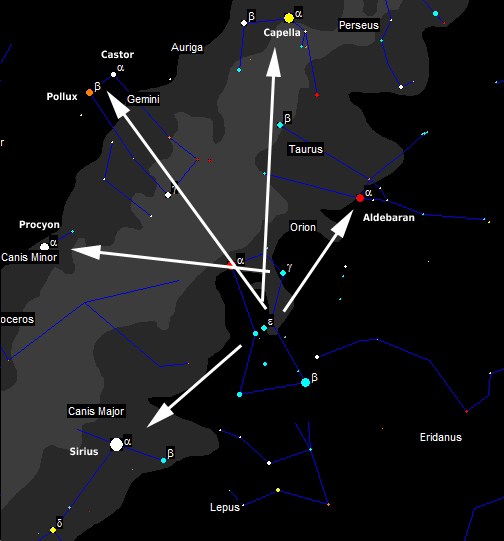Blog
Night Sky - February 2017
February Skies 2017
Chart shows the night sky at around 8 PM, mid month.

The SW sky continues to be dominated by the planet Venus, blazing away in the twilight sky and visible for several hours after Sunset. Those of you with tripod mounted binoculars that have been looking at the planet over the past couple of months will start to see a significant change in the appearance of Venus. For most of January, Venus appeared telescopically as a ½ moon phase, but as an effect of our motion around the Sun, the Venusian phase will change from a “thick” crescent -40% lit- at the start of Feb, to a much “thinner” crescent -18% lit- by the month end.
Almost overwhelmed by the nearby Venus in the sky is Mars, still glowing a dull ruddy red hue to the upper left of Venus. Visually it is “past it’s best” for observing but remains visible for a couple of months to come.
The King of the planets, Jupiter, is starting to become more easily visible now. By mid Feb, it is rising around 11 PM in the SE sky, just above the bright star Spica. Again, those with binoculars or telescopes will be able to watch the “dance” of the four brightest satellites around Jupiter as they orbit the planet, and larger telescopes will see some of the atmospheric cloud belt features.
For the early risers amongst us, Saturn will be visible from around 5AM low in the SE sky.
Nothing really happening much on the meteors side for February. It’s typically a “quiet” month with no major showers active until April actually. You will still get the odd and unpredictable sporadic meteors, so it’s always worth keeping your eyes open, you just never know what you may spot.
A couple of photo opportunities between the Moon and planets occur during the month if you fancy a try. On the 1st and 2nd Feb, the Moon will be close by the Venus and Mars pairing, and will be so again on the 28th or try around the 15th and 16th of Feb to catch the Moon close to the Jupiter and Spica pairing.

If your just getting into astronomy however and learning your way around the sky, February is a very good month as the bright and obvious constellation of Orion is due South at a sensible time. Orion is an excellent “signpost” to find other star patterns or constellations in the sky. Have a look at the Orion picture below. Locate the three stars that make up the diagonal “belt” of Orion. Follow them down and to the left and you’ll come to the brightest star in the sky, Sirius in Canis Major (the Big Dog). Follow the belt stars the opposite way, upwards and to the right, and you’ll arrive at the red star Aldebaran in the constellation of Taurus the Bull. From the middle of the belt, make a line straight upwards through the “head” of Orion and almost overhead, you’ll discover the yellowish star Capella, in the constellation of Auriga the Charioteer. Take a line from the right hand belt star and extend through Betelgeuse, the top left star in Orion. This line will point you to the two brightest stars in Gemini the twins, Castor and Pollux and then finally, take a line through the top two stars in Orion and extend this to the left and you’ll find Procyon in Canis Minor, the Little Dog.
So there you have it. From knowing just one constellation – Orion – you now know how to find five others, and this is the way to learn your way around the sky, jumping off from constellation to constellation. - Enjoy!
Supplied by MidWales Astronomy www.midwalesastronomy.cymru/
